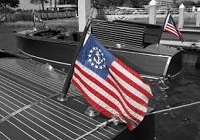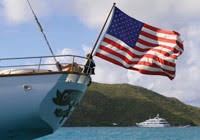Boat/Maritime Protocols

1. Single Mast (no Yard or Gaff)
• U.S. Ensign (flag) is flown at the truck (#1).
• All other flags are pennants flown below U.S. Ensign.
2. Mast with Yard:
• U.S. Ensign (flag) is flown at the truck (#1).
• Club burgee (flag) is flown at the starboard (right) yard arm (#3).
3. Mast with a Yard and Gaff:
• U.S. Ensign (flag) is flown at the gaff (#2).
• Club burgee (flag) is flown at the truck (#1).
• Flags at #3 and #4 vary depending on the activity at the club.
It is display #3 which causes the most confusion. This puts the club burgee in a higher position physically, but not above that of the U.S. Ensign (flag) symbolically. By the normal Flag Code provisions, this would seem to be an incorrect display. The tradition of the seas, however, is to hold the gaff as the position of honor; thus, the intent of this tradition and display is to give proper respect to the flag.
Where a yard is involved, rules provide that when a foreign ensign is displayed, the U.S. Ensign (flag) is flown at #3; the foreign ensign at #4; the club burgee at #1; and other flags at #2.
The gaff extends aft (to the rear), and a mast on yacht club grounds is faced seaward. Therefore the gaff will (or should) be directed toward the land. The observation point then becomes a point somewhere on the sea side of the mast. This then makes the placement of the U.S. Ensign (flag) in regard to the foreign ensign conform to Flag Code provisions.
Focus is placed on 4 main flags used by please crafts, charterers and charter boat owners: Ensign or the National flag, Club Burgee, Private Signal, and Courtesy Flags.
Ensign


Boats should fly the National Flag. Most pleasure vessel in US waters have a choice of.
The yacht ensign, with its fouled anchor over a circle of 13 stars, the "Betsy Ross" flag. Originally restricted to documented vessels only, it is now commonly flown on recreational vessels of all types and sizes instead of the National Flag (see picture).
The 50-star flag "Old Glory", our nations flag for all occasions.
The appropriate time to fly the ensign is from 0800 to sunset, except when racing. It is also important to take the flag down prior to leaving the vessel, if the vessel will be unmanned at the time of sunset.
However, whenever a vessel is taken into international or foreign waters, the 50-star U.S. ensign is the proper flag to fly and the vessels ensign cannot to be displayed. In other words, if you own a US vessel in the British Virgin Islands, you should not fly the Ensign, instead the National Flag.
vessels today fly the ensign from the stern, which provides the best visibility, but it can also be flown from the leech of the most after-sail. When flown from the stern, it should be on a staff (pole) that is sufficiently long and angled, and that is offset to one side (traditionally the starboard side), so the flag flies clear of engine exhaust and rigging.
Burgee



It is a small flag displaying the symbol of the skipper's yacht club or other sailing organization. It may be flown day and night.
Most people opt to fly the burgee lower in the rig, hoisted to the end of the lowest starboard spreader on a thin flag halyard. While purists rail this practice, it is an accepted adaptation of another tradition, which is that the starboard rigging is a position of honor (when you visit a foreign port, that's where we fly the host country's flag). Besides being reasonable, flying the burgee in the starboard rigging is such a widespread custom that to try to end it would be close to impossible.
Private Signal


It is a small, custom-designed and custom-made flag that carries symbols standing for the owner, so it can basically be anything. The signal may be flown day or night, but is not displayed when another sailor is in command. (The rule is: the private signal and burgee follow the sailor, not the boat.)
On a multi-mast vessel, the private signal is flown at the head of the aftermost mast. On a sloop, the private signal may be flown from the starboard rigging, either below the burgee or alone.
Courtesy Flags

As a matter of courtesy, it is appropriate to fly the flag of a foreign nation on your vessel when you enter and operate on its waters. There are only a limited number of positions from which flags may be displayed. Therefore, when a flag of another nation is flown, it usually must displace one of the flags displayed in home waters. However, it is hoisted only after the appropriate authorities have granted clearance. Until clearance is obtained, a boat must fly the yellow "Q" flag. All charter boats should carry the national flags of neighboring islands as well as the yellow" Q" flag, in case charterers want to visit those islands.
The courtesy flag is flown at the boat's starboard spreader, whether the United States ensign is at the stern staff, or flown from the leech. If there is more than one mast, the courtesy flag is flown from the starboard spreader of the forward mast.
Final notes, it is also a common courtesy to fly the national flag(s) of your guest(s) on board, if they have a different nationality than the ensign is showing.
Flags' Dimensions
The size of a nautical flag is determined by the size of the boat that flies it.
The flag at the stern of your vessel: U.S. ensign or national flag should be about one inch for each foot of overall length. For example, on a 40ft. boat, the ensign should be 40 in. i.e. about 3.5ft.
Other flags, such as club burgees, private signals and courtesy flags used on sailboats should be approximately 1/2 inch for each foot of the highest mast above the water. For example, on a 30ft. boat, with 50ft. between the masthead and the water, the burgee should be about 25 in. The shape and proportions of pennants and burgees will be prescribed by the organization which they relate to.
Raising and Lowering Flags
Fly the ensign from morning (8:00 a.m.) to evening (sunset) whether the boat is at rest, under sail, or under power. The exception to this rule is: The ensign is not flown by a boat in a race, which signals to other boats that you are racing.
To prevent wear and tear, the flag may not be flown when out of sight of other vessels or when nobody is aboard. The flag is flown while entering or leaving a port, even at night. For purists: In the morning, the ensign is hoisted rapidly before other flags. In the evening, it is lowered slowly and with ceremony after other flags come down.
